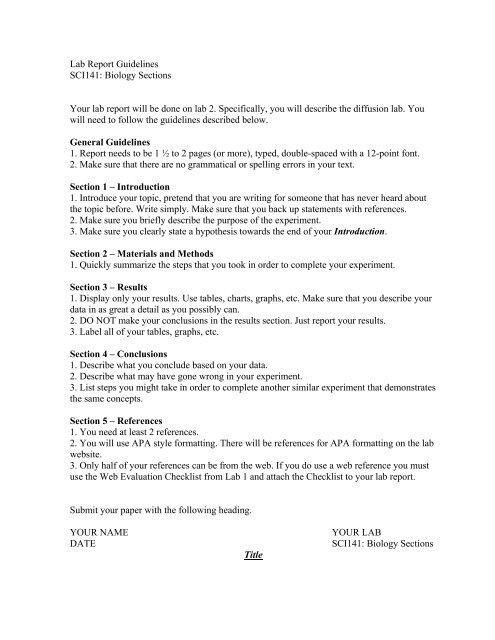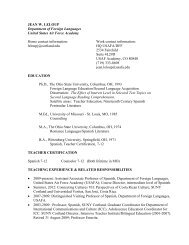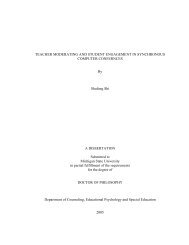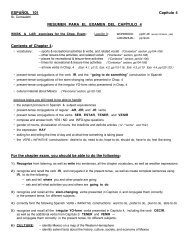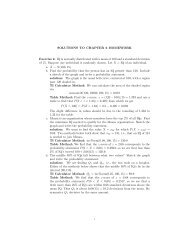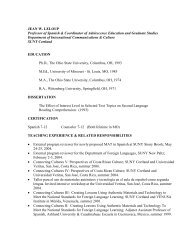Lab Report Guidelines SCI141: Biology Sections Your lab report will ...
Lab Report Guidelines SCI141: Biology Sections Your lab report will ...
Lab Report Guidelines SCI141: Biology Sections Your lab report will ...
You also want an ePaper? Increase the reach of your titles
YUMPU automatically turns print PDFs into web optimized ePapers that Google loves.
<strong>Lab</strong> <strong>Report</strong> <strong>Guidelines</strong><strong>SCI141</strong>: <strong>Biology</strong> <strong>Sections</strong><strong>Your</strong> <strong>lab</strong> <strong>report</strong> <strong>will</strong> be done on <strong>lab</strong> 2. Specifically, you <strong>will</strong> describe the diffusion <strong>lab</strong>. You<strong>will</strong> need to follow the guidelines described below.General <strong>Guidelines</strong>1. <strong>Report</strong> needs to be 1 ½ to 2 pages (or more), typed, double-spaced with a 12-point font.2. Make sure that there are no grammatical or spelling errors in your text.Section 1 – Introduction1. Introduce your topic, pretend that you are writing for someone that has never heard aboutthe topic before. Write simply. Make sure that you back up statements with references.2. Make sure you briefly describe the purpose of the experiment.3. Make sure you clearly state a hypothesis towards the end of your Introduction.Section 2 – Materials and Methods1. Quickly summarize the steps that you took in order to complete your experiment.Section 3 – Results1. Display only your results. Use tables, charts, graphs, etc. Make sure that you describe yourdata in as great a detail as you possibly can.2. DO NOT make your conclusions in the results section. Just <strong>report</strong> your results.3. <strong>Lab</strong>el all of your tables, graphs, etc.Section 4 – Conclusions1. Describe what you conclude based on your data.2. Describe what may have gone wrong in your experiment.3. List steps you might take in order to complete another similar experiment that demonstratesthe same concepts.Section 5 – References1. You need at least 2 references.2. You <strong>will</strong> use APA style formatting. There <strong>will</strong> be references for APA formatting on the <strong>lab</strong>website.3. Only half of your references can be from the web. If you do use a web reference you mustuse the Web Evaluation Checklist from <strong>Lab</strong> 1 and attach the Checklist to your <strong>lab</strong> <strong>report</strong>.Submit your paper with the following heading.YOUR NAMEDATETitleYOUR LAB<strong>SCI141</strong>: <strong>Biology</strong> <strong>Sections</strong>
SAMPLE LAB REPORT<strong>SCI141</strong>: <strong>Biology</strong> <strong>Sections</strong>IntroductionAll cells are bound by a functional cell membrane. The cell membrane functions toprotect a cell and to regulate the movement of molecules and ions into and out of cells. Allcell membranes are either semi permeable (permeable to only water) or selectively permeable(permeable to molecules based on some determining factor). Experimental conditions cansimulate cell membranes to show their selective permeability. Dialysis tubing can simulate aselectively permeable membrane.What a selectively permeable membrane can prevent (selectively) is the normaldiffusion of molecules. Diffusion is the passive process by which molecules and ions <strong>will</strong>move from areas of high concentrations to low concentration. Dialysis tubing <strong>will</strong> beselectively permeable based on the size of the molecule trying to diffuse through themembrane.This experiment <strong>will</strong> examine four molecules and their permeability. The moleculesare, in order of increasing size, iodine, water, dextrose, and starch. Based on the sizepermeability of the dialysis tubing, iodine, water, and dextrose <strong>will</strong> be able to diffuse acrossthe selectively permeable membrane. The large molecular size of starch <strong>will</strong> prohibit itsdiffusion.In order to verify the results of this experiment, <strong>will</strong> have to be able to detect thediffusion of the molecules. Two tests exist in order to verify the diffusion of our molecules. 1)When starch and iodine interact the form a bluish black color. Therefore, anywhere anoticeable bluish black color change occurs, both starch and iodine <strong>will</strong> be present. 2)Benedict’s reagent, when applied to heat, <strong>will</strong> detect the presence of sugar (like dextrose). Apositive Benedict’s test at the end of the experiment <strong>will</strong> verify the presence of sugar.Materials and MethodSee attached handout.
ResultsBeaker Contents- Starch/IodineReaction- Benedict’s TestCell Contents- Starch/IodineReaction- Benedict’s TestBefore the ExperimentWater, Iodine- Negative- NegativeWater, Starch, Dextrose- Negative- PositiveAfter the experiment???- Negative- Positive???- Positive- PositiveThe iodine/starch reaction was only positive inside the cell, indicating that iodine had enteredthe cell, while starch did not diffuse out of the cell. A Benedict’s test was Positive both insideand outside of the cell. This indicates that dextrose was able to diffuse out of the cell. Therewas no test that measured the diffusion of water. Visual observation confirmed that thedialysis tube was more turgid after the experiment. This could be possible verification of thediffusion of water.ConclusionWater, iodine, and dextrose are all molecules that were able to diffuse across theselectively permeable membrane, based on their established concentration gradients. Theresults showed several tests that verified the diffusion of those molecules. This verifies theoriginal hypothesis that molecules that fit the size requirement of the selectively permeablemembrane (dialysis tubing) <strong>will</strong> be allowed to diffuse across their concentration gradients.Starch, however, failed to diffuse because it size must have been too large to be compatiblewith the selectively permeable membrane.


